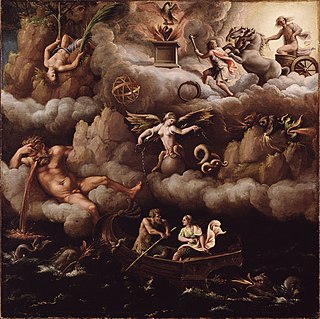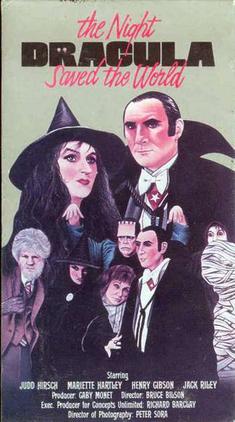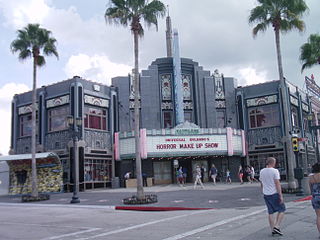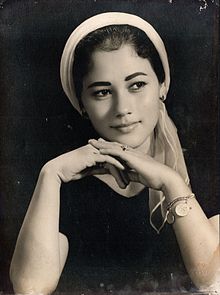
A monster is a type of fictional creature found in horror, fantasy, science fiction, folklore, mythology and religion. Monsters are very often depicted as dangerous and aggressive with a strange, grotesque appearance that causes terror and fear. Monsters usually resemble bizarre, deformed, otherworldly and/or mutated animals or entirely unique creatures of varying sizes, but may also take a human form, such as mutants, ghosts and spirits, zombies or cannibals, among other things. They may or may not have supernatural powers, but are usually capable of killing or causing some form of destruction, threatening the social or moral order of the human world in the process.
Hammer Film Productions Ltd. is a British film production company based in London. Founded in 1934, the company is best known for a series of Gothic horror and fantasy films made from the mid-1950s until the 1970s. Many of these involve classic horror characters such as Baron Victor Frankenstein, Count Dracula, and the Mummy, which Hammer reintroduced to audiences by filming them in vivid colour for the first time. Hammer also produced science fiction, thrillers, film noir and comedies, as well as, in later years, television series.

Van Helsing is a 2004 action horror film written and directed by Stephen Sommers. It stars Hugh Jackman as Dutch monster hunter Van Helsing, and Kate Beckinsale as Anna Valerious. Van Helsing is both a homage and tribute to the Universal Horror Monster films from the 1930s and 1940s, of which Sommers is a fan.

Terence Fisher was a British film director best known for his work for Hammer Films.

Jack Pierce was a Hollywood make-up artist best remembered for creating the iconic makeup worn by Boris Karloff in Frankenstein (1931), along with various other classic monster make-ups for Universal Studios.

Monster Force is a 13-episode animated television series created in April 9, 1994 by Universal Cartoon Studios and Canadian studio Lacewood Productions. The story is set in approximately 2020 and centers on a group of teenagers who, with help of high tech weaponry, fight off against classic Universal Monsters and spiritual beings threatening humanity. Some of the crew have personal vendettas, while others fight for mankind out of a sense of altruism. The series aired in syndication alongside another Universal animated series, Exosquad. Universal Studios Home Entertainment released the first seven episodes to DVD on September 15, 2009.

House of Frankenstein is a 1944 American horror film starring Boris Karloff, Lon Chaney Jr. and John Carradine. The film was directed by Erle C. Kenton based on a story by Curt Siodmak, and produced by Universal Pictures. The film is about Dr. Gustav Niemann who escapes from prison and promises to create a new body for his assistant Daniel. The two murder Professor Lampini and take over his sideshow that involves the corpse of Count Dracula. After disposing of the Count, the two move on to the ruins of Castle Frankenstein where they find the body of Frankenstein's monster and The Wolf Man Larry Talbot preserved in the castle. Niemann thaws them and promises to cure Talbot of his werewolf curse, but secretly plots to revive Frankenstein's monster instead.

House of Dracula is a 1945 American horror film released and distributed by Universal Pictures. Directed by Erle C. Kenton, the film features several Universal Horror properties meeting as they had done in the 1944 film House of Frankenstein. The film is set at the castle home of Dr. Franz Edelmann, who is visited first by Count Dracula and later by Larry Talbot, the Wolf Man, who are trying to cure their vampirism and lycanthropy, respectively. Talbot is eventually cured, which leads him to discover the body of Frankenstein's monster in a cave below the base of the castle. Edelemann takes the monster's body back to his laboratory but finds Count Dracula has awakened and by attacking his assistants, he captures Edelmann and forces a reverse blood transfusion, which gives Edelmann a split personality and makes him a killer.

Commander USA's Groovie Movies is an American movie showcase series that ran weekend afternoons on the USA Network.

Universal Classic Monsters is a home video line based on a series of horror films primarily produced by Universal Pictures from the 1930s to the 1950s. Although not initially conceived as a franchise, the enduring popularity and legacy of the films and the characters featured in them has led the studio to market them under the collective brand name of Universal Studios Monsters. Steve Jones of USA Today described Universal's most famous monsters as "pop culture icons", specifically Dracula, Frankenstein, the Creature from the Black Lagoon, the Mummy, and the Wolf Man.

The Halloween That Almost Wasn't is a 1979 American television special that revolves around Dracula trying to save Halloween from the Witch who threatens it. It won an Emmy Award for "Outstanding Individual Achievement – Children's Program" and was nominated for three others. On its VHS release, it was retitled The Night Dracula Saved the World.
David John Skal is an American historian, critic, writer, and on-camera commentator known for his research and analysis of horror films, horror history and horror culture.

Universal Orlando's Horror Make-Up Show is a live show located at Universal Studios Florida that opened on June 7, 1990, along with the theme park. It is a live demonstration of Universal Pictures' legacy of horror movies, with particular emphasis on prosthetic makeup. It was inspired by the former The Land of a Thousand Faces show (1975–1980) at Universal Studios Hollywood. It is also notable for being one of two original opening-day attractions still in operation at Universal Studios Florida, the other being E.T. Adventure.

Monster Brawl is a 2011 independent Canadian horror comedy film.

Mummies are commonly featured in horror genres as undead creatures wrapped in bandages. Similar undead include skeletons and zombies.
The Wolf Man is the title of several horror film series centered on Larry Talbot, a man who upon being bitten by a werewolf becomes one himself, and his subsequent attempts to cure himself of his murderous condition. The franchise was created by Curt Siodmak.
The World of Hammer is a British television documentary series created and written by Robert Sidaway and Ashley Sidaway, and produced by Robert Sidaway.

The history of horror films is one that was described by author Siegbert Solomon Prawer as difficult to read as a linear historical path, with the genre changing throughout the decades, based on the state of cinema, audience tastes and contemporary world events.















